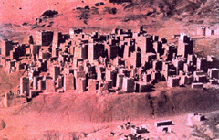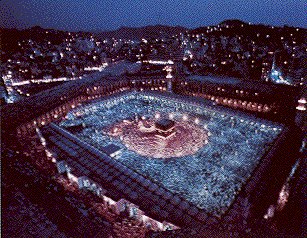
African Influence on Islam

As discussed in African Influence on Judaism, there was a considerable amount of African derived symbols and stories which found their way into the Hebrew religious system. An offshoot of Judaism, Christianity naturally adopted many of these beliefs itself and even added a few. The story of Africa and Islam is also one of proximity and cultural influence. |

French archaeologist Francois Lenormant wrote, We may perceive the remembrance of a powerful empire founded by the Cushites in very early ages, apparently including the whole of Arabia Felix, and not only Yemen proper. While Lenormant's claims are probably a bit too far reaching, Arabia has long housed a significant African population, particularly in the South. How long these Blacks inhabited the Arabian peninsula is unknown. The Africa and Arabia connection should not be surprising as the distance between the East African horn and Southern Arabia is minimal. In fact linguists such as Joseph Greenberg contended that the Semitic languages of Arabia and the Middle East may well be a branch of a larger Ethiopian language group. It is also well known that this Eastern Horn-Arabian route was used for millennia by the earliest homonid migrants who later populated Asia. At least by 1,000BC Ethiopia, Eritrea and what is Southern Yemen may have been part of a larger empire known as the Sabean Kingdoms. The people of Sabea (Sheba) were probably a mixture of East Africans and Souther Arabians who had long populated the region. Saba had a very matrifocal society with a host of female deities. Lokman, considered the 'wisest man of the ancient East' was one of these Africans. The famed poet Antar was yet another. Pictured above are the ruins of Marib, a city of Saba (Sheba) in Southern Yemen. (Photo courtesy of The African Ark, African Presence in Early Asia and Yemeni website)
|

The most profound influences upon Islam by African religions can be seen in the goddesses of ancient Arabia. It is often disputed whether these deities are originally Arabian or African. As ancient Saba included what is today Ethiopia and southern Yemen, we shall designate these deities Afro-asiatic just as the Semitic tongue is called. Long before Allah, Arabia was home to an Afo-asiatic goddess called All'at. This goddess was popular all throughout Arabia and was worshipped by the Prophet's family himself. Another goddess was El'Ka'ba. Long before Mohammad, the jet black stone at Mecca was a holy site to the worshippers of El'Ka'ba who came to kneel at her symbol, a jet black stone. It should be again noted that as in the Hebrew Cabala, the Islamic Ka'ba refers to the two parts (Ka and Ba) of the Kemetan soul. Pictured here is the Islamic holy site of the Ka'ba attended by millions yearly. (Photo and Information courtesy of African Origins of Western Religions by Dr. Yosef-ben Jochannan and Man, God and Civilization by John G. Jackson)
|

As late as the 7th Century AD these Blacks figure into Arabian culture and the coming of Islam. Mihdja, a Black man, is said to be the first Muslim killed in battle while another, Bilal, is regarded as a "third of the faith." Dhu'l-Nun al-Misri, born in Upper Egypt near Sudan, is regarded as the founder of Sufism. Today Sufism's greatest stronghold is in Southern Egypt and Sudan. Most controversial of all are the writings of a contemporary 9th Century Black scholar in residence at Baghdad by the name of Abu 'Uthman' Amr Ibn Bahr Al-Jahiz. Al-Jahiz, to confront a growing tide of anti-black sentiment in the Muslim world, published a highly controversial work at the time titled, Kitab Fakhr As-Sudan 'Ala Al-Bidan, "The Book of Glory of the Blacks over the Whites." Al-Jahiz in his work contended that even the Prophet Mohammad's father may have been of African lineage. (Photo courtesy of The African Ark,African Presence in Early Asia and Yemeni website)
|





